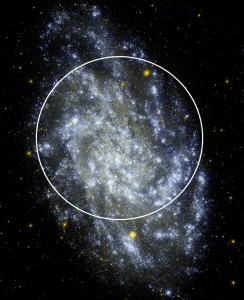By John Hutchings (NRC)
(Cassiopeia – Winter 2014)

The GALEX UV image of M33 with the UVIT field of view superposed. UVIT will have several times better resolution, and a suite of filters and gratings for such studies.
On this schedule, early science will begin after commissioning in late 2015, and proposal time will begin six months later. The instrument teams are making detailed plans for guaranteed time observations, some of which are simultaneous monitoring at all wavelengths from hard X-ray to visible. The Astrosat website gives an overview of its capabilities. If you have ideas for early science, let me know, as it may be possible to work them into the UVIT observing plans.









